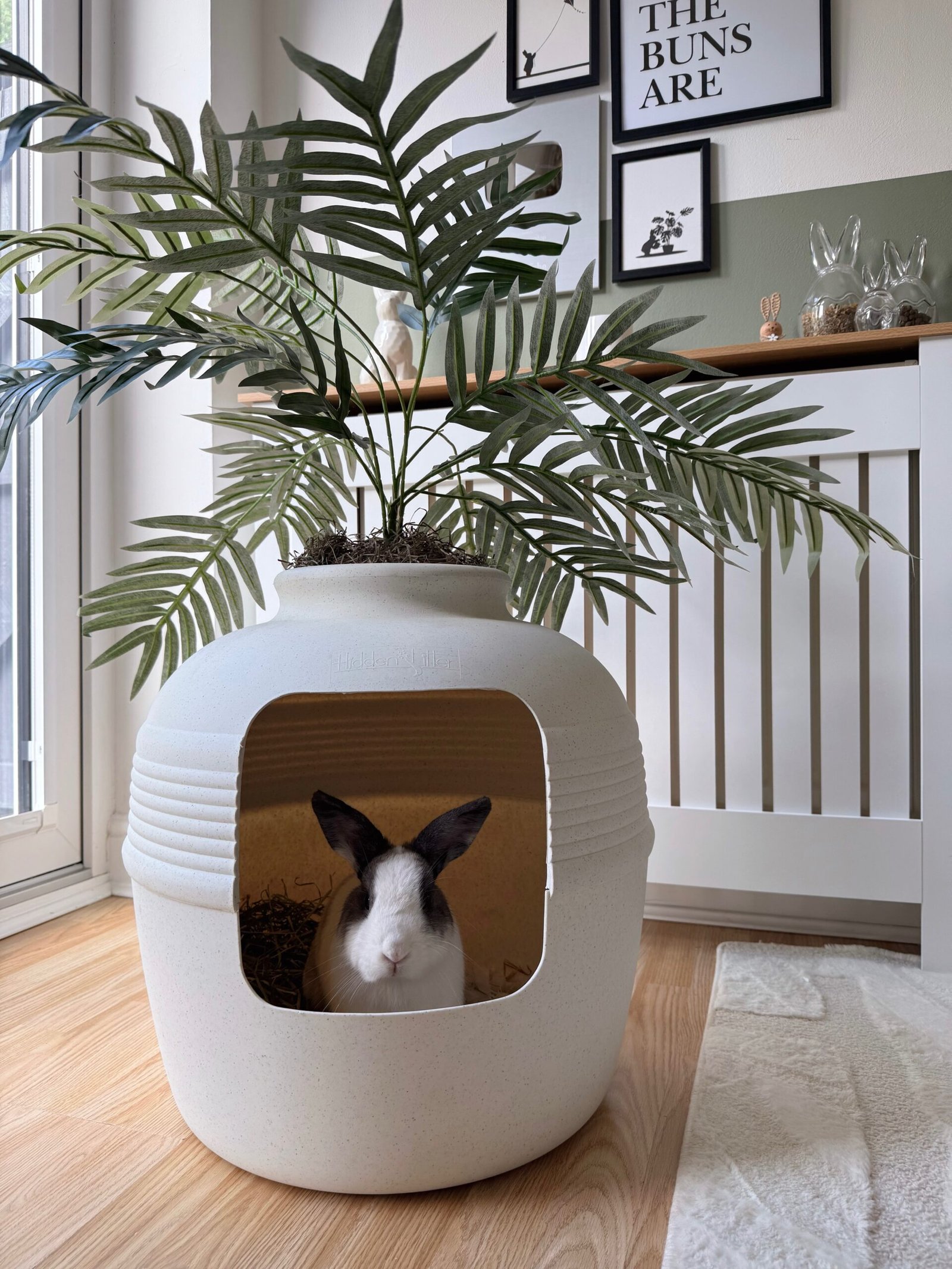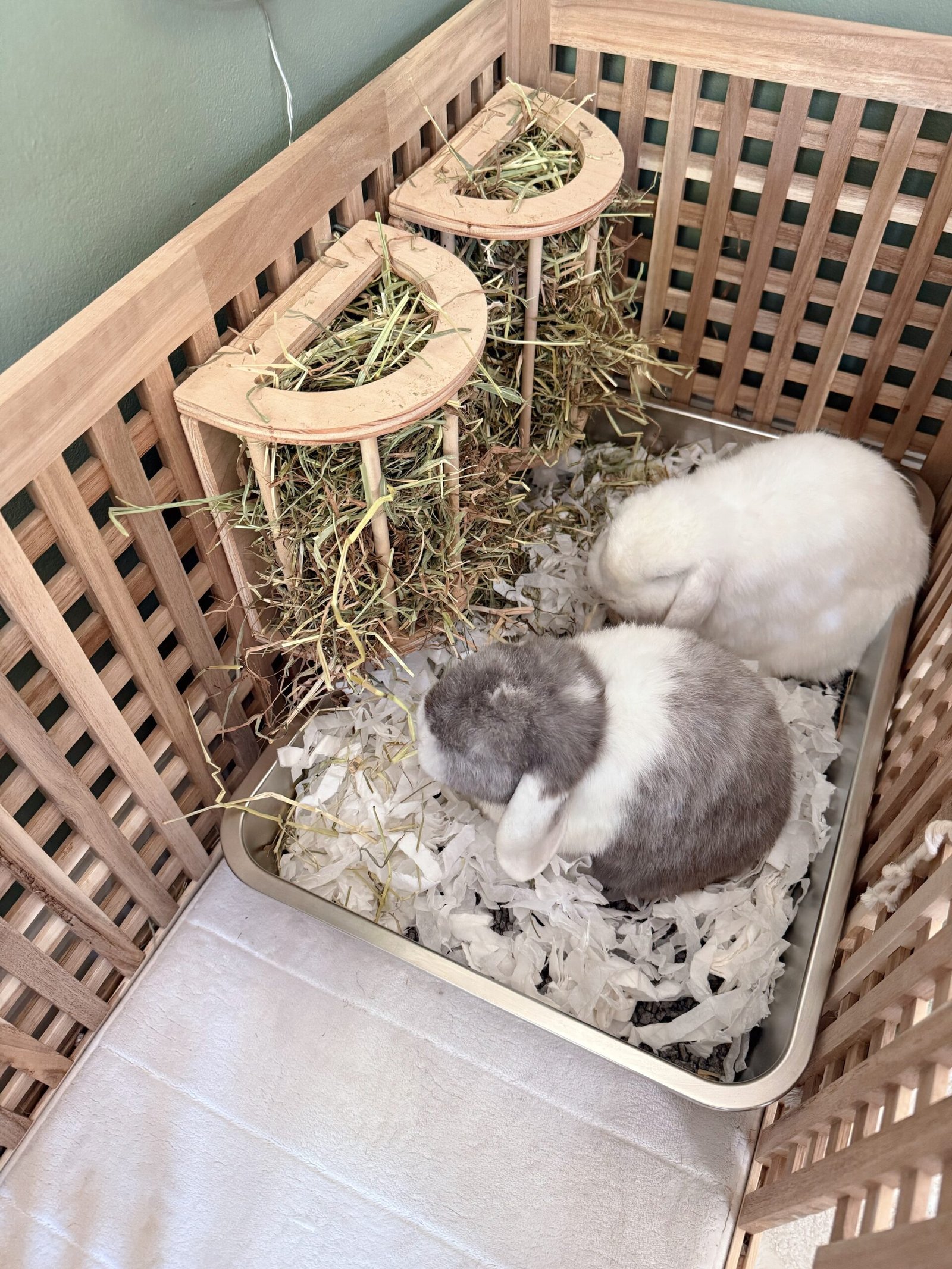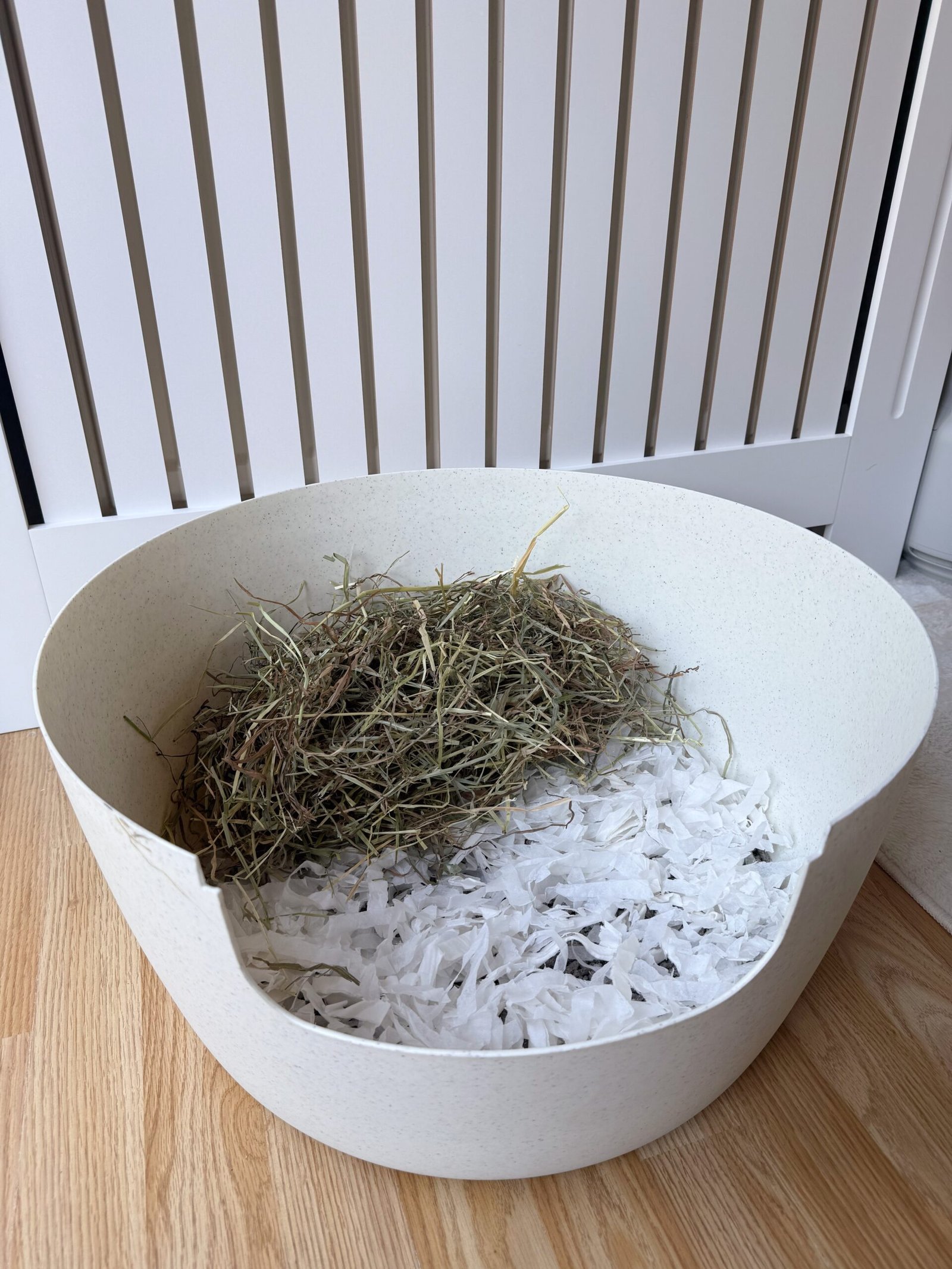How to Litter Train Your Rabbits: A Guide for Bunny Parents
If you’re a bunny parent like me, you’ll know that rabbits are clever little creatures – and yes, they can be litter trained! Whether you’re new to bunny life or just want to tidy up your rabbit’s space, litter training is a great step towards a cleaner, more harmonious home.
Here’s everything you need to know to get started.

This post contains affiliate links – I may earn a small commission if you buy through them, at no extra cost to you
Jump to a section:
Why Litter Train Your Rabbits?
What You’ll Need
Step-by-Step Guide
A Note About Neutering
Our Setup & Litter Training Story
What Works for Us
Litter Training FAQs
Final Thoughts
Why Litter Train Your Rabbits?
- It keeps their living area (and yours!) much cleaner.
- It makes daily spot-cleaning quick and easy.
- It helps to monitor their health – you’ll be able to notice changes in urine or poo quickly.
What You’ll Need
- A suitable litter tray: Cat litter trays work well.
- Rabbit-safe litter: Such as wood pellets or paper-based options. Avoid clumping/clay cat litter.
- Hay rack or pile of hay: Rabbits love to eat and poop at the same time!
- Cleaning supplies: White vinegar is great for neutralising odours.
Step-by-Step: How to Litter Train Your Rabbits
- Choose the Right Location
Rabbits tend to pick a corner to do their business. Watch where they go most often and place a litter tray in that spot. - Limit Their Space at First
If your rabbit has free roam, start by litter training them in a smaller area first – you could use C&C grids or a playpen to section off an area. Once they get the hang of it, you can slowly increase their space. - Add Litter and Hay
Line the tray with a layer of rabbit-safe litter and add a big pile of hay on the one side or place a hay rack just above the tray. This encourages them to use the tray while munching. - Keep It Clean, But Not Too Clean!
Clean the tray every other day, but leave a little soiled litter behind at first – the scent helps them know it’s the right place to go. - Accidents Happen!
If your rabbit has an accident outside of the tray, blot the urine with tissue and place it in the litter box – you can pop stray poops in too. This helps to reinforce the right spot. Clean the area with white vinegar afterwards to eliminate lingering scents. - Be Consistent and Patient
Some rabbits take to litter training straight away, while others might need a little longer. That’s okay! Never punish your rabbits for accidents – they won’t understand, and it can cause stress. - Adjust As Needed
If your buns are using more than one spot, add extra litter trays to those areas. You can gradually reduce these down to one or two trays as soon as their toilet habits are consistent.
A Note About Neutering
You can begin litter training at any age, but keep in mind that unneutered rabbits may mark their territory when hormones kick in – this can mean spraying and poor litter habits. This behaviour usually improves significantly once they’ve been neutered or spayed.
But neutering isn’t just helpful for litter training, it’s also important for your rabbit’s long-term health and wellbeing.
Health & Behavioural Benefits of Neutering:
- Reduces hormone-driven behaviours like spraying, aggression, and mounting
- Prevents uterine cancer in female rabbits – most unspayed females sadly develop this by age 4
- Neutering is vital for bonding – it helps reduce aggression and territorial behaviour, so rabbits can live together happily and safely
- Prevents accidental litters
Our Setup & Litter Training Story
Litter training each of our rabbits has been a slightly different experience, but with patience and the right setup, our trio have had solid litter habits for years now.
Ronnie
Ronnie picked up litter training very quickly when he was younger, but as we were delayed in getting him neutered due to the Covid restrictions, his litter habits went completely out the window once his hormones kicked in. We had lots of territorial marking – he would spray urine up the cupboards, even up my legs! He also started leaving piles of poops here, there and everywhere. Thankfully a month after this started we were able to get him neutered and straight after his neuter his litter habits returned to normal!
Daisy
Daisy was super easy to train, taking to the litter box straight away. We never had any issues with territorial marking — even before her spay, her hormones never really kicked in to cause any of those behaviours. Having her neutered has helped maintain her good habits long-term, and comes with many health benefits too.
Willow
When we rescued Willow, we weren’t sure of her living conditions before us, but as her owners dumped her, we can only presume it was likely she lived in a cage, where she had to eat, sleep and toilet all in the same spot. It took a good few weeks to litter train her, and just when she was getting the hang of it, her hormones kicked in and her habits went completely out the window. We had a date for her spay and up until this day we had lots of territorial marking, lots of poops everywhere – but this stopped straight after her spay.
What Works for Us
Over time, we’ve found a setup that works really well for our trio:
- We use a stainless steel litter tray inside our IKEA HOL – it’s easy to clean, fits perfectly, and helps contain the mess. The size of this one is 60x45x10cm.
- We also have a plant-style litter box that blends in nicely with the bunny room but still functions well for them.
- We have an additional stainless steel litter box that I use to create large forage/dig boxes. I usually give them one once a week and remove it after 24 hours. We also use this litter box for when they are enjoying time in the garden too. The size of this one is 60x45x15cm.
- For litter, I now mainly use Back-2-Nature or Breeder Select, both are very similar (but usually one of them is on offer, so I rotate between the two). They are absorbent, odour-controlling, and safe for rabbits. Carefresh is also a favourite, though I don’t use it as much anymore.
- On top, I add Burgess Excel Nap and Nest – it’s super soft and comfy on their little paws, as they do spend a majority of their time munching away in their litter boxes.
- The plant litter box has a generous amount of hay at the one end, and inside the IKEA HOL, hay is placed in their hay feeders positioned above their litter box, encouraging them to hop in and use it while munching.
I do quick daily cleans of their room every morning, clean out their litter boxes every other day and do bigger cleans weekly, which keeps everything tidy and fresh. Having a consistent routine – with feeding, cleaning, and space setup – also plays a big role in helping them stay on track with their litter habits.
Of course, there are still the occasional poops outside of the trays – that’s just normal bunny behaviour! But overall, the routine works perfectly for our buns and keeps their space clean, comfy, and easy to maintain.

Inside the IKEA HOL – Ronnie and Daisy enjoying their hay above the litter tray 
A look inside our plant-style litter box – we keep a pile of hay at one end
Litter Training FAQs
Do I need a litter box for each rabbit?
Not necessarily — bonded rabbits often share a litter box. However, offering more than one tray not only helps if they choose separate spots, but also gives them more opportunities to toilet throughout their space, which can encourage good habits and reduce accidents.
How big should the litter box be?
The bigger, the better! Your rabbit should be able to sit, stretch, and turn around comfortably. For bonded pairs, trios or groups, use extra-large trays.
How long does litter training take?
Some rabbits learn within a few days, others take a few weeks or longer. Hormones, previous habits, and environment all play a role — just stay consistent.
Can outdoor rabbits be litter trained?
Yes! Litter training works for both indoor and outdoor rabbits — the key is using trays where they naturally go and keeping them clean.
Why is my neutered rabbit still leaving poops around?
Even neutered rabbits may leave a few poops outside the tray as a way of marking their territory — it’s completely normal and usually not a concern.
What litter types should I avoid?
Avoid clumping or clay-based litters, as well as anything scented or dusty. These can be harmful if ingested or cause respiratory issues.
Is it too late to train an older rabbit?
Nope! Rabbits of any age can learn – it might just take a little longer and extra patience.
Final Thoughts…
Litter training your rabbits might take a little patience, especially if hormones or past experiences come into play, but it’s absolutely achievable. With the right setup, a consistent routine, and a bit of understanding, you’ll be well on your way to a cleaner, happier bunny space.
And remember — the occasional stray poop is totally normal in the world of buns!
If you’ve got any litter training questions, need some advice, or just want to share your own bunny journey, feel free to reach out over on Instagram @ronnietheminilop.
Thanks for reading – and happy litter training!













Products We Use & Recommend